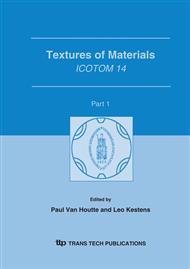[1]
J.P. Joule: On a new class of magnetic forces, Ann. Electr. Magn. Chem. 8 (1842) 219-224.
Google Scholar
[2]
J.P. Joule: On the effects of magnetism upon the dimensions of iron and steel bars, Phil. Mag (3) Vol. 30 (1847)76-87, 225-241.
Google Scholar
[3]
C. Chen: Magnetism and Metallurgy of Soft Magnetic Materials, Dover Publ. Inc, New York, 1977 (reprint 1986), Chapter 3.
Google Scholar
[4]
E. Villari: Change of magnetisation by tension and by electric current, Ann. Phys. Chem. 126 (1865) 87-122.
Google Scholar
[5]
D.C. Jiles: Theory of the magnetomechanical effect, J. Phys. D: Appl. Phys. 28 (1995) 1537.
Google Scholar
[6]
D.J. Buttle, W. Dalzell and P.J. Thayer: Nondestructive Rapid Residual Stress Measurements in Rail Heads with Maps, British Institute of NDT, proc. NDT 2001 conf., 18-20 Sept. 2001, Coventry, England.
Google Scholar
[7]
J.F. Kelleher, D.J. Buttle, P.M. Mummery, and P.J. Withers, Residual Stress Mapping in Railway rails, Proc. 7th int. Conf. On Residual Stresses (ICRS7), Xian, China, June 14-17, (2004).
Google Scholar
[8]
K.H. Lo, D.J. Buttle and P. Mummery: The Effects of Service Lifetime and Duty on the Residual Stress in Railway Rails, Proc. 6th Eur. conf. on Residual Stresses (ECRS6), 10-13 July 2002, Coimbra, Portugal, Materials Science Forum, vols. 404-407, pp.881-886, Trans Tech Pub (2002).
DOI: 10.4028/www.scientific.net/msf.404-407.761
Google Scholar
[9]
D.L. Atherton and D.C. Jiles: Effects of Stress on Magnetization, NDT International, Volume 19, no. 1, February 1986, pp.15-19.
DOI: 10.1016/0308-9126(86)90135-5
Google Scholar
[10]
W. Mao and D.L. Atherton: Effect of compressive stress on the reversible and irreversible differential magnetic susceptibility of a steel cube, J. of Magnetism and Magn. Materials 214 (2000) 69-77.
DOI: 10.1016/s0304-8853(00)00040-8
Google Scholar
[11]
W. Mao and D.L. Atherton: Effect of compressive stress on magnetisation components of a line pipe steel cube, Res. Nondestr. Eval (2001) 167-177.
DOI: 10.1080/09349840008968169
Google Scholar
[12]
G.L. Burkhardt and H. Kwun: Application of the Nonlinear Harmonic Method to Stress Measurement in Steel, Proceedings of the 1987 Review of Progress in Quantitative NDE, " Volume 7B, Edited by D. O. Thompson and D. E. Chimenti, New York: Plenum Press, 1988, p.1413.
Google Scholar
[13]
A. Takahashi: Stress Diagnosis of Middle Presser Gas Pipes on Bridges Just After Kobe Earthquake Using Non-Destructive Inspection Technique, presented on the Third Taiwan-Japan Workshop on Lifeline Performance and Disaster Mitigation, May (2004).
Google Scholar
[14]
Y. Sakai, H. Unishi and T. Yahata: Non-destructive Method of Stress Evaluation in Linepipes Using Magnetic Anisotropy Sensor, JFE Technical Report No. 3 (July 2004) 47-53.
Google Scholar
[15]
R.M. Bozorth: Ferromagnetism, 1951, D. Van Nostrand, New York; Reissued by IEEE Press, New York, (1993).
Google Scholar
[16]
J. Kanamori: in Magnetism, Vol. 1 (1965), Academic Press, New York.
Google Scholar
[17]
S. Chikazumi: Physics of Magnetism, 1964, Wiley, New York, p.182.
Google Scholar


